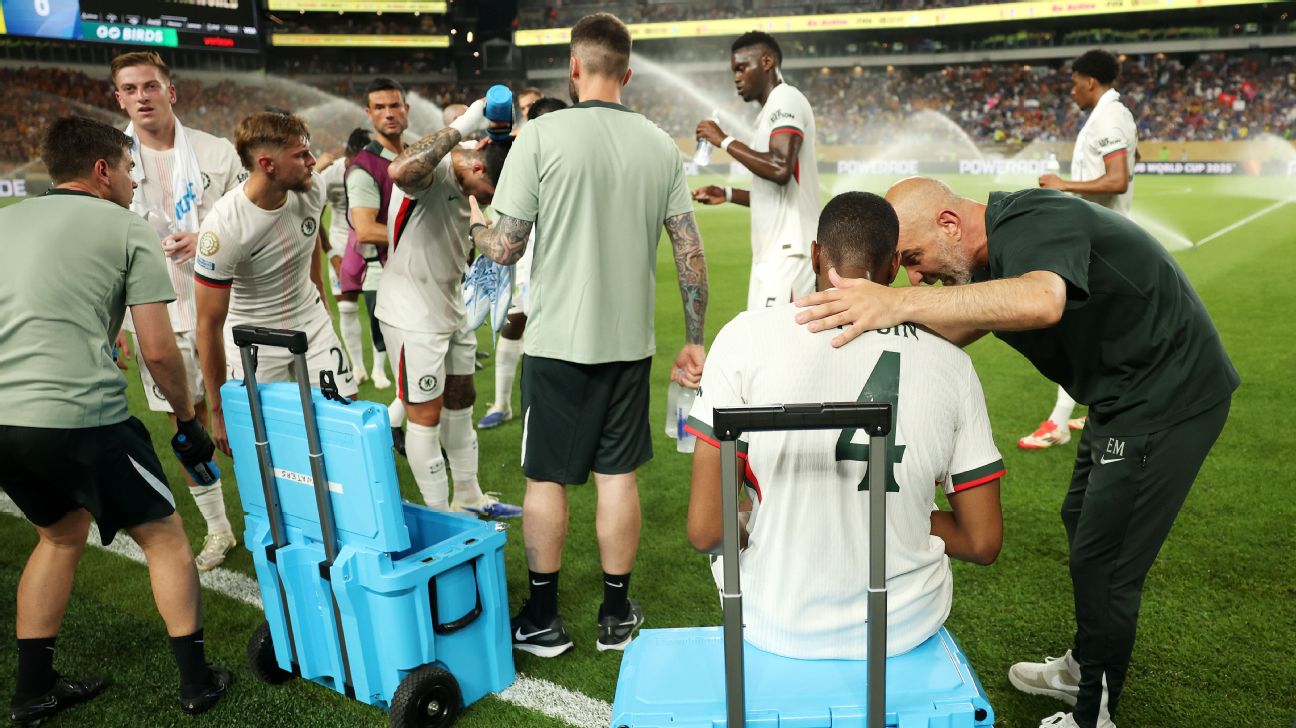The 2025 FIFA Club World Cup is in the books, but even as the dust settles after Chelsea’s rout of Paris Saint-Germain in Sunday’s final at MetLife Stadium, preparations for next summer’s 2026 FIFA World Cup — hosted across the U.S., Canada and Mexico from June 11 to July 19 — are already well underway. Much of what we saw and experienced of the U.S. as a host nation this summer will inform issues in need of fixing over the next 12 months.
ESPN’s reporters who covered the 2025 summer tournament weigh in on the glaring needs FIFA can’t afford to ignore if next summer’s showpiece sporting event is to be one of its best.
Bad weather could lead to fixture pileups
Of all issues that affected the Club World Cup, the weather had the biggest impact on the quality of matches. Manchester City played their first group game at noon in Philadelphia, with no sun coverage, and their second at 9 p.m. in Atlanta’s air-conditioned stadium. Afterward, Pep Guardiola talked about the matches as if his team had played two different sports.
The intensity of the performance was certainly different in Atlanta. In Philadelphia, City defender Nathan Aké said the pace of the game against Wydad AC dropped when the clouds opened and the sun came out. The heat was that oppressive.
The issue ahead of the 2026 World Cup is that some teams will have to play in early afternoon matches in places like Miami, where temperatures will reach 90 degrees and higher. With so many games to fit in, there’s no other way around it. FIFA can’t have all the games kicking off late in the evening at air-conditioned stadiums. It’s just not viable.
The biggest question facing FIFA ahead of the World Cup is how to make it fair. England’s chances of lifting the trophy will be boosted immeasurably if they play most of their games in covered stadiums like the ones in Atlanta or Houston. On the flip side, if Thomas Tuchel’s side are asked to play at lunchtime in Miami, they’re going to struggle. Think Brazil in 2014, when England finished bottom of their group and went home early.
By hosting a World Cup in the summer in the U.S., FIFA has already agreed to be hostage to the weather, with both hot/humid conditions and thunderstorms capable of delaying games. But with wildly different conditions in different stadiums and venues, it needs to do everything it can to make the tournament as fair as possible. — Rob Dawson
Kickoff times: Make it make sense for the players, not the TV audience
Most World Cups have taken place during summer in the Northern hemisphere, which makes a bit of heat and humidity par for the course. However, throw in North America’s thunderstorms — which delay games — and the impact of the weather is going to be potentially next-level. This is where, off the back of the 2025 Club World Cup, FIFA needs to be clever in terms of both venues and kickoff times.
With four games each day from June 13-23 and a whopping eight (in four slots) from June 24-26, it won’t be straightforward. But FIFA has several cards to play if it is willing to learn from 2025 and not get overly hung up on kickoff times.
Six of the 16 venues are in relatively temperate climates, while another three are climate-controlled. It seems obvious that if you are going to play in the middle of the day, you should do it in those cities, wherever possible.
As for the stadiums most likely to be affected by the weather? Well, they play at night, and if it means kicking off at 10 p.m. local time, so be it. They do it occasionally in Spain’s LaLiga, so they can do it here, too. FIFA has to give itself that option.
Maybe at the Club World Cup, there was a desire to put big clubs in the European prime time to boost TV audiences. Well, FIFA doesn’t need to do this for the World Cup because unlike its little sibling, there’s no proof of concept needed. History shows folks will stay up into the middle of the night or the early morning (let alone daytime hours at work).
The World Cup does not need to cater to TV. What it does need to do, wherever possible, is give players the best possible conditions to do what they do best. — Gab Marcotti
Challenging travel leaves little room for error
The United States is a huge country and one that’s accustomed to moving people around by rail, road or air, but there is also a built-in acceptance in the U.S. that stuff happens: weather can cause delays or cancellations, the trains don’t run on time and the roads, especially in the big cities, can be chaotic. The system works (with glitches), but it will come under immense strain next summer when the U.S., Mexico and Canada welcome fans for a 48-team World Cup.
The biggest issue will be the capacity for air travel. I personally had three internal flights during the Club World Cup, and they were delayed by three hours, 11 hours and one hour. Stormy weather was the reason for two of them and technical issues the other. There will be some delays that cause fans to miss games.
Such disruptions will affect teams, too. Real Madrid had to cancel their semifinal prematch news conference because bad weather forced their flight to be delayed.
Trains? They get you to where you want to go, but don’t expect to make the relatively short journey from Manhattan to MetLife Stadium in New Jersey in under an hour. And both to and from the Club World Cup final, trains were canceled.
Some stadiums are also way out of town, the Hard Rock in Miami being an example of a ground that is really only accessible by car. Next year will be impacted by travel issues, so prepare to be patient. — Mark Ogden
Hard-to-reach venues will dampen fan experience
For U.S. sports fans who regularly visit some of these stadiums — whether it’s New Jersey’s MetLife, Miami’s Hard Rock or Pasadena’s Rose Bowl — it goes without saying that arriving and departing is often a long and painful process requiring plenty of patience, planning, and above all, time.
Ask anyone who has attended several games at this tournament and they’ll have their own “journey from hell” anecdote. At the Rose Bowl — which isn’t one of the World Cup venues, instead being replaced by Los Angeles’ SoFi Stadium — a number of journalists, including those with international news agencies, arrived at close to halftime in the stadium’s debut match, PSG vs. Atletico Madrid, after getting caught up in traffic jams.
At Miami’s Hard Rock Stadium, driving or catching an Uber is no guarantee of arriving before kickoff. The stadium’s security perimeter — set up to prevent a repeat of last summer’s Copa America chaos — is so extensive that a long, sweaty walk in Florida’s heat and humidity is required anyway to get to your gate. Even the buses provided by FIFA for journalists — which worked well at most venues, and really should be the blueprint for an expanded program that caters to fans with tickets in 2026 — suffered long delays after getting stuck in traffic.
MetLife’s location in East Rutherford has long been a bone of contention for New Yorkers. Get caught in rush-hour traffic and the journey by road from Manhattan can literally take hours. Kickoff was delayed in the Real Madrid vs. PSG semifinal after even the teams arrived late. And yes, NJ Transit runs a special train service for events, with the station close to the stadium, but that still involves a change — and sometimes a long wait — at nearby Secaucus Junction.
Efficiently getting tens of thousands of fans in and out of stadiums at sold-out sporting events is inevitably complicated. But the lack of adequate public transport infrastructure, coupled with some out-of-town locations, for a number of these venues is going to cause a major headache in 2026 unless FIFA provides additional, free shuttle buses running frequently for fans. — Alex Kirkland
Artificial pitches and makeshift turf are a real problem
PSG coach Luis Enrique said Seattle’s Lumen Field resembled an “NBA court full of holes” before doubling down by adding that the “ball bounces like a rabbit.” Real Madrid midfielder Jude Bellingham said the pitches in general “aren’t great at all … [and] tough on the knees as well. Hopefully someone will look at that going into the World Cup next year.”
FIFA needs to. After all, this wave of frustration follows on from criticism of the surfaces used during last year’s Copa America, including Argentina goalkeeper Emiliano Martínez labelling the Mercedes-Benz Stadium pitch in Atlanta a “disaster.”
Five of the venues used at the Club World Cup — Lumen Field, Mercedes-Benz Stadium, Hard Rock Stadium, MetLife Stadium and Philadelphia’s Lincoln Financial Field — will be employed at next summer’s World Cup, and there is clearly work still to be done. They are NFL stadiums using artificial turf, incompatible with FIFA’s requirement that all its competitions are played on entirely natural grass surfaces. The Club World Cup was an experiment in that regard, as FIFA tried to innovate new techniques to create a hybrid surface, including transporting Bermuda grass overnight in refrigerated trucks to improve the quality.
Furthermore, while many participants complained about the extreme temperatures, stadiums with roofs make it harder to grow and maintain real grass with natural sunlight. Four of the 16 venues next summer — Atlanta, Dallas, Houston and Vancouver — have roofs.
“We’ll report after this tournament and take lessons forward to 2026,” said MetLife pitch venue manager Blair Christensen at the tournament’s conclusion. “These guys here that work on the pitch with me, they are far sharper and better than they were 35 days ago, and we’ll take that forward to next year.” — James Olley
Will the players be fit and ready?
The 2025 Club World Cup saw 32 teams from around the globe participate in an extensive competition under extreme conditions, facing intense heat, logging thousands of miles in travel across the United States between games and playing on makeshift pitches to replace artificial grass in certain venues.
While Major League Soccer players entered the competition amid the ongoing 2025 campaign, and with fresher legs given that their offseason runs from early December to late February, most clubs were forced to play just weeks after grueling campaigns: all four Brazilian teams (Flamengo, Palmeiras, Fluminense, Botafogo) had played 70 or more games, with Chelsea and Manchester City clocking in with 57 across all competitions. Exhaustion often showed in the performances, leading to forced substitutions, concern for injuries and, at times, an arguably less intense level of football on the pitch.
It’s not over for these players either, with MLS clubs returning to their regular season and European clubs preparing for the 2025-26 campaign. With just one year until the 2026 World Cup, players and clubs missed out on a crucial summer break, and they must now balance avoiding injuries and playing time while still being competitive, with players keen to earn a spot in their national team’s roster. We have yet to see whether this tournament will have consequences. Once participating players kick off the 2025-26 campaign and weekly action is underway, players might begin to experience the Club World Cup’s lasting impact. — Lizzy Becherano




